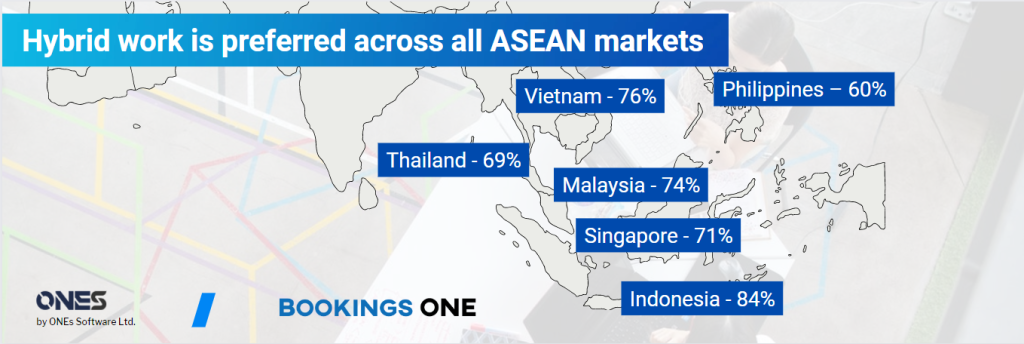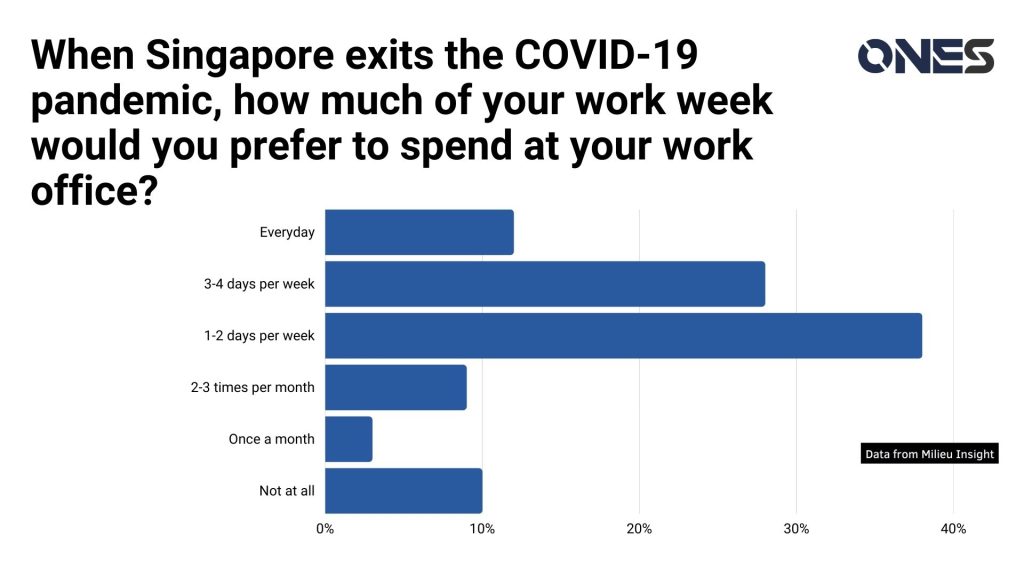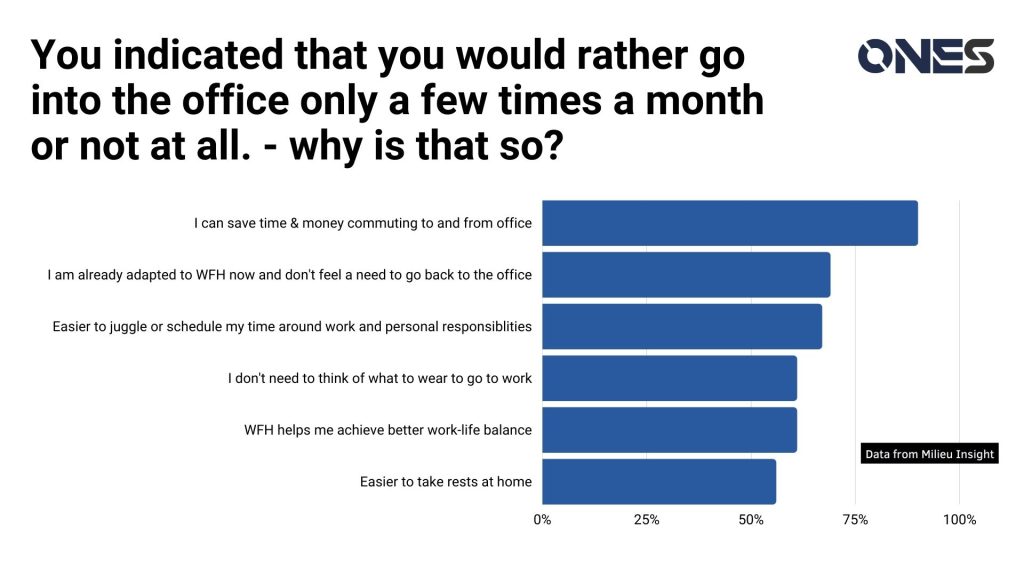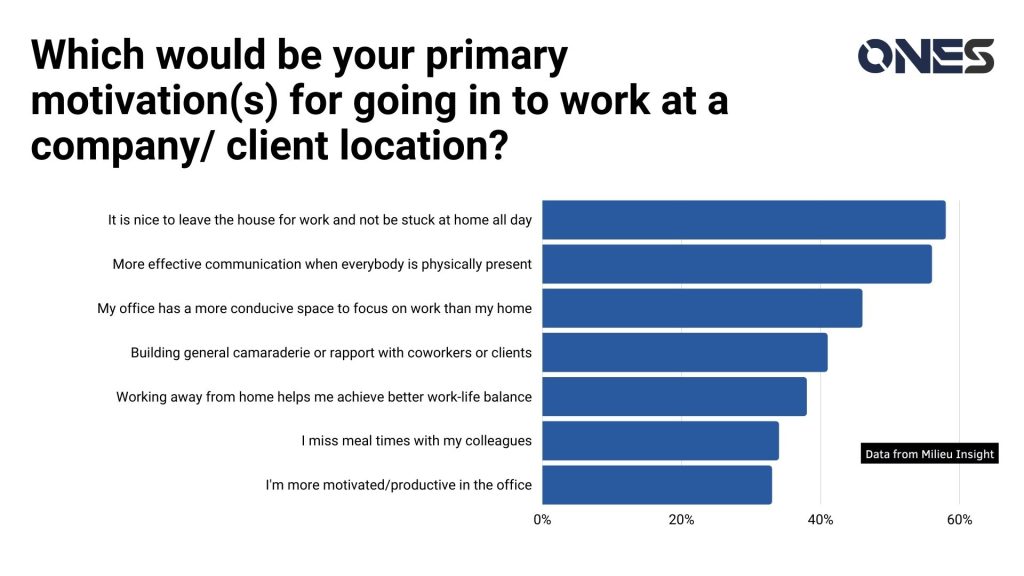After entering the transition phase, Work-from-home is no longer the default in Singapore from Jan 1, 2022. This means that Singapore has already started to go back to a normal working style.
This article will show what business leaders must recognize how, when, and where we work are no longer constrained by traditional notions of time and space in this new hybrid working era.
“In Singapore,” said Joanna Lim, Modern Work and Security Business Group Lead, Microsoft Singapore, “we recently moved from being allowed to return to the workplace, back to where working from home is once again our default.
As businesses adapt to the disruptive change, business leaders must recognize that long-held assumptions no longer hold true with their employees. They must now make choices that will impact their organizations for years to come.
Joanna Lim, Modern Work and Security Business Group Lead, Microsoft Singapore
Table of Contents
What is Hybrid work?
Hybrid work is an approach that takes into account the individual’s needs, whether they’re at home or at the office. Our platform enables people to work from any location, and move between sites as needed.
Many organizations see hybrid work as the evolution of remote working, allowing employers to better integrate remote working into overall business processes while providing comparable work experience for remote workers.
In the report “Making Flexible Work, Work: Towards Better and More Inclusive
Work-Life Practices” from Malaysia, Singapore & Brunei Darussalam, there are several nice definitions for flexible working terms:
Work-Life Practices (WLPs)
Various forms of support for work-life integration, including leave, support networks, facilities, etc. This includes Flexible Work Arrangements.
Flexible Work Arrangements (FWAs)
Flexibility in the time and location of work. This includes Work From Home arrangements.
These arrangements aim to provide greater flexibility
in the following areas: the workplace, scheduling of hours worked, number of
hours worked and flexibility of job roles.
The top FWAs in the Life at Work Survey were:
- Flexi Hours (48%)
- Leaving Early From Work (34%)
- Staggered Hours (22%)
- Job Sharing (19%)
- Work-From-Home/Telecommuting (16%)
Work-From-Home (WFH)
A subset of FWAs, in which employees may work remotely some or all of the time
Learn more:
Post-MCO Safety Guidelines Info Page
How can hybrid working help Singaporeans and their companies save their daily expenses now?
20+ Questions for your Hybrid Working Employee Survey
Why Hybrid Working is the winner in the APAC region? Experts explain.
Hybrid work is preferred across ASEAN markets

The Cisco study highlighted that hybrid work is now preferred by many employees across ASEAN markets:
- Singapore – 71%
- Malaysia – 74%
- Indonesia – 84%
- Vietnam – 76%
- Thailand – 69%
- The Philippines – 60%
The support for hybrid work extends beyond employees as well — with 90% of employees saying their employers have been supportive of hybrid working. In particular, 46% said their employers have been supportive, while 44% said their employers have been very supportive.
(Cisco)
Who is implementing hybrid working in Singapore?
Beyond the COVID-19 epidemic, the banking industry in Singapore, for example, is implementing flexi-work as a permanent component, although the hybrid model implemented by each bank differs.
UOB, for example, has implemented a two-day work-from-home policy, allowing workers to organize their work depending on where they can be most efficient.
Similarly, DBS allows employees to work remotely up to 40% of the time and plans to launch a Living Lab that combines physical and virtual workspace configurations to facilitate discussions and cross-team collaborations.
HSBC, on the other hand, has three work arrangements based on job roles: office workers are permanently office-based due to compliance reasons or the need to be client-facing, flexible office workers are primarily office-based and may work from home one to two days per week, and flexible home workers have a fixed schedule that includes at least 50% work-from-home time.
Citi intends to offer its global workforce a new work model that provides consistency, permanency, and flexibility. The new work model will classify staff into three globally consistent role designations, helping identify the best model of flexibility and helping them achieve better work and life balance.
Under the new model, employees worldwide are divided into three globally consistent role designations. The new work model applies to Citi’s 8,500 employees in Singapore.
Global communications agency Redhill decided to move its new global headquarters to Singapore Tanjong Pagar on September 2022. Up to 150 employees can work in the new 5,000-square-foot area in Tanjong Pagar, which is intended for hot desking.
Timeline of Singapore Workplace Requirements in Response to Covid-19
Work-from-home is no longer the default in Singapore from Jan 1, 2022, and a higher focus on Workplace Strategy is expected as more people return to the office.
While new Covid-19 variations are possible hazards that might hinder the return to work, the degree of concern is low. Disruptions are anticipated to be less severe in 2022 than they were in the early days of the epidemic.
With nearly two years into the pandemic, Singapore is now better prepared to respond effectively. Even when new Covid-19 types develop, pandemic efforts may become more focused and subtle in the future. This is backed up by the high immunization rate.
As of 10 January 2022, approximately 87% of Singapore’s population had been fully vaccinated, a significant improvement from early April 2021, when less than 10% of the population had been fully vaccinated.
As a result, firms will be more confident in expanding their office footprint as the economy recovers.
General hybrid working data
Singapore’s CBD Grade A office
According to Savills research, the vacancy level of Grade A office space in the city-central state’s business area (CBD) in Singapore continues to decline for the second consecutive quarter.
The vacancy rate of such office properties fell by 1.2 percentage points quarter on quarter in Q3 2022, to 5.6 percent, following a 0.4 percentage point drop in the previous three months.
According to Savills, the decrease in vacancy levels was seen across all three grades of office buildings, particularly in Grade AA offices, where the vacancy rate fell by 2.4 percentage points on a quarterly basis.
The office submarkets of Orchard Road and Marina Bay, in particular, had the lowest office vacancy rates of 1.7 percent and 2.4 percent, respectively.
(Savills)
According to JLL, it only took 18 months for Singapore’s CBD Grade A office rentals to recover from the COVID-19 pandemic.
According to the real estate consultancy’s research, the gross effective rent for CBD Grade A office space increased 2.9% year on year to SGD 11.06 per sq ft per month in 3Q22, up from SGD 10.74 per sq ft per month in 2Q22. This has surpassed the pre-pandemic peak of SGD 10.81 psf per month recorded in 4Q19 and is the highest since SGD 12.55 in 4Q08.
(JLL)
Future Sources of Office Demand
Technology and financial occupiers will continue to be the major sources of office demand in 2022 as they expand headcounts amidst an economic recovery. Technology and finance occupiers drove about 65% of new leases within the CBD in 2021 .
On the other hand, co-working operators (real estate), once a major driver of CBD office demand, have slowed their expansion spree since the pandemic struck, albeit continuingly picking up pockets of space.
Some co-working operators are evolving their business models to an asset light strategy, preferring management agreements from direct leases of space.
Given occupiers increased demand for flexibility and flex space, co-working demand is still expected to expand albeit at a more measured pace.
Proportion of workers in the resident labor force who WFH due to the COVID-19 situation
As the global Covid-19 situation worsened in 2020, businesses adopted a new mode of operation, allowing their employees to work from home (WFH). Singapore is no exception, with 49 percent of employed residents working remotely by 2020.
This resulted in one of the highest proportions of resident employees working remotely when compared to other European Union (EU) member states such as Belgium and Finland, where more than half of employed residents worked remotely. ( Labour Force in Singapore 2020 edition: Impact of COVID-19 on the Labour Market )
Work-from-home is no longer the default in Singapore
When will work from home end in Singapore?
From Jan 1, Work-from-home is no longer the default in Singapore from Jan 1, 2022.
50 percent of employees who can work from home will be allowed to return to the office, said the Ministry of Health (MOH) on Tuesday (Dec 14, 2021). (channelnewsasia)
Singapore employee data
Flexible work is here to stay in Singapore
More than 82 percent of Singapore workers want flexible remote work options to stay, but 66 percent want more face-to-face time with their teams.
The majority of workers in ASEAN (72%) choose a hybrid working style that combines in-office and remote work, as opposed to a totally remote (23%) or in-office (5%) experience, indicating that workers are aware that the future of work will be hybrid.
Similar results were found in Singapore, where respondents preferred a hybrid of a remote and in-office working paradigm to a wholly remote (25%) or fully in-office (4%) experience in the future.
(Cisco Global Hybrid Work Study 2022)
By Logitech’s report, 63% of respondents said they preferred hybrid work arrangements, while 25% would opt for fully remote work practices and 9% wanted everyone to be back in the office.
(Logitech)
Flexible work retains Singapore talent
Over 50% of Singapore workers surveyed said they would consider leaving their jobs if asked to return full-time to the workplace.
(People at Work 2022: A Global Workforce View)
Also, based on the IPS study that asking if they would consider looking for another job if their employer requires them to return to the office on most days, 37 percent of respondents faced with this prospect said that they would consider looking for another job during the period between Dec 28 last year and Feb 22.
But among those surveyed from March 18 to April 11, when there was a further relaxation of Covid-19 measures, this figure grew to 42 percent.
People with caregiver duties prefer flexible work arrangements
Respondents with aged persons at home were more likely to feel that flexible work arrangements should be the new norm for workplaces (52%) as compared to those with children (44%) or those with both children and aged persons at home (37%).
Those with children at home were more likely to feel that working from home on most days should be the new norm at workplaces (28%) compared to those with aged persons (22%) or those with both aged persons and children at home (25%)
However, more respondents with both children and aged persons at home also feel that working from the office on most days should be the new norm for workplaces (38%) as compared to respondents with children (28%) or respondents with aged persons at home (26%).
Preference for remote work and hybrid work in Singapore

The ability to work remotely appears to be the most popular option among Singapore employees, with the majority (78 percent) preferring a hybrid schedule.
Employees are far less enthusiastic about committing to a single environment: only 12% prefer working from the office all the time, and 10% prefer working remotely full-time. (Milieu Insight)
Unalignment between leader and workers in Singapore
According to research, 51 percent of Singaporean leaders are thriving right now, while only 27 percent of employees (without decision-making power) are. (Microsoft)
Singapore Gen Z is exhausted
Gen Z (aged 18 to 25) is particularly vulnerable, as more than 70% of this generation in Singapore believes they are merely surviving or struggling. (Microsoft)
Workers in ASEAN report productivity improvement
In ASEAN, 64% of workers reported an increase in productivity, and 65% of employees felt that working hybrid had improved the quality of their work. The same number of respondents (66%) also mentioned improvements in professional knowledge and abilities.
Particularly in Singapore, the figures were a little lower:
- Employees feel that their work quality has increased, according to 56% of them.
- 60% think productivity has increased.
While 76% of employees in Singapore agreed, over 75% of employees in ASEAN thought that their role can now be completed as successfully from home as it can in the office.
(Cisco Global Hybrid Work Study 2022)
Employees believe hybrid work can save their time
One of the advantages noted is that hybrid work gives workers their time back; 73% of ASEAN respondents reported saving more than four hours per week as a result. Even more, 32% managed to save more than eight hours. 65% of people were able to reinvest the extra time by spending it with their family, friends, and pets thanks to the time saved on reduced or no commuting, and impromptu office contacts.
In Singapore, the figures stayed largely the same, with 70% saving over four hours and 28% saving over eight.
(Cisco Global Hybrid Work Study 2022)
Employees believe hybrid work can improve social and physical wellbeing
When it comes to the social side, 86% of ASEAN respondents reported better relations with family, while 55% reported better contact with friends. (74%, 50%, Singapore).
In terms of health, 77% of ASEAN citizens reported eating healthier, 79% reported exercising more, and 78% reported being physically fitter. 72% of Singaporeans agreed to believe that their physical fitness had improved, following a similar trend.
(Cisco Global Hybrid Work Study 2022)
Employees believe hybrid work can save their money
In terms of money, 86% of workers in ASEAN reported saving money, with an average saving of over US$7,462.52 per year, or US$143.51 per week. This roughly equated to an increase in savings of 14.5%.
The top three places to make savings were specifically:
- Commuting costs (88%)
- Food and entertainment (75%)
- Lifestyle and social activities (60%)
(Cisco Global Hybrid Work Study 2022)
A study by the Institute of Policy Studies in Singapore found that Singaporeans thought flex-work benefits save on daily expenses. The reasons are as follows:

- Reduce the chance of getting Covid-19: Preventing paying medical expenses; (87%)
- Greater Flexibility in incorporating personal life needs with work schedules (83%)
- Less money and time spent on commuting: Allowing staff to work at home. (78%)
- Less need to dress for work: No need to go back to the office for work. (75%)
Reasons why Singaporeans choose remote office

In addition to saving time and money on commuting to and from work, those on hybrid work arrangements cited improved work-life balance and a less stressful working environment as benefits of working from home.
Those currently working in a hybrid work arrangement appear to have a higher quality of life because they have more time and fewer office stressors. (Milieu Insight)
Reasons why Singaporeans choose to work at office/client location

Admins wanted to understand employees’ primary motivation(s) for going to work with the hybrid model designed for flexibility of working remotely while still offering structure, stability, and social benefits.
According to the survey of Milieu Insight, employees are motivated to come to work to meet with their teams and colleagues for collective work, brainstorming sessions, building connections, and other social rituals.
To be truly successful with a hybrid work arrangement, businesses should consider transforming their offices to accommodate what these spaces will actually be used for – for employees to innovate, collaborate, and connect. (Milieu Insight)
Crucial digital transformation strategy
According to 72% of workers, one crucial transformation strategy is to expand the function of human resources to encompass comprehensive hybrid rules and guidelines. This may involve influencing an organization’s productivity measurement system, like Microsoft Viva.
(Telstra)
Singapore employer data
Top 3 ICT spend by Singapore companies
The top 3 information and communications technology (ICT) spent by Singapore market are:
- Data and analytics to measure productivity
- Cloud infrastructure and services
- Internet of Things
(Telstra)
How employers in Singapore are approaching hybrid work
Employers in Singapore expect the majority of their workforce to work remotely in Q1 2022, with the exception of those in production/manufacturing and frontline sales/front office/customer-facing roles, where 45 percent and 29 percent of employers expect their employees to work in the workplace all the time, respectively.
In terms of human resources, 24% of employers polled said they would expect their HR teams to work remotely all the time, while 65% expected a hybrid arrangement (25 percent indicated working remotely twice or more a week, 40% indicated thrice or more), and 8% expected HR to work in the workplace all the time. (ManpowerGroup)
Optimizing Hybrid Work with New Technology
A majority of APAC leaders and employees (70%) saw a progressive change with clear guidelines to achieve full hybrid policies.
Currently, organizations were measuring productivity by setting goals for communication frequently (57%), using tools for teamwork and collaboration (56%), and the output based on the work completed (50%).
For future productivity strategies, organizations indicated that they would look toward future-focused goals (66%), consistent policy on performance rating (58%), and updated performance indicators (53%).
(Telstra)
Redesign office for hybrid working
62% of business leaders are more likely to redesign office space to accommodate hybrid work.
More information for hybrid working
Businesses General Requirements in Singapore
https://www.gobusiness.gov.sg/safemanagement/general/
FAQs on Safe Management Measures at the workplace
https://www.mom.gov.sg/covid-19/frequently-asked-questions/safe-management-measures
ONES All-in-one smart office system
ONES Software now has a dedicated page to introduce a series of hybrid working measures to help you solve problems. You may wish to go to https://ones.software/sg/hybrid-workspace/ for further reference.
Contact us: hello@ones.software, or visit ONEs Software official website for more information: https://ones.software/.


